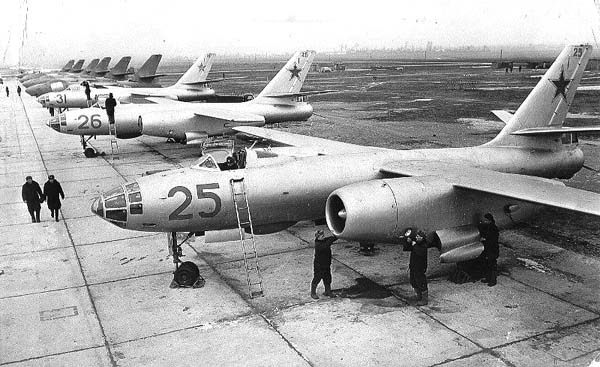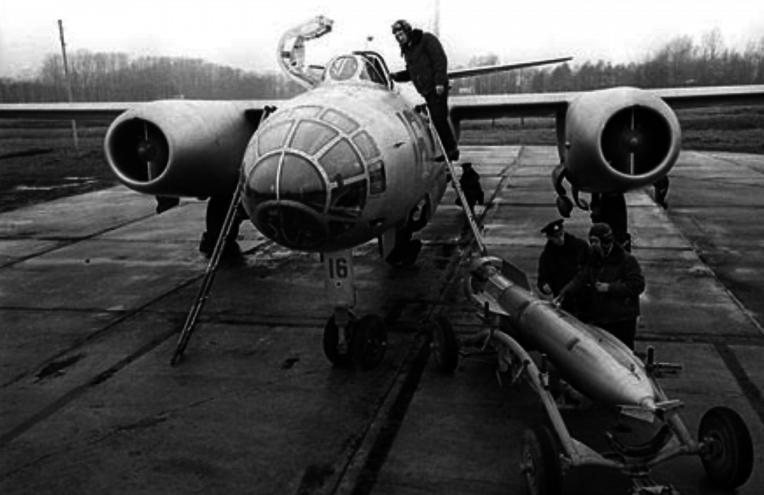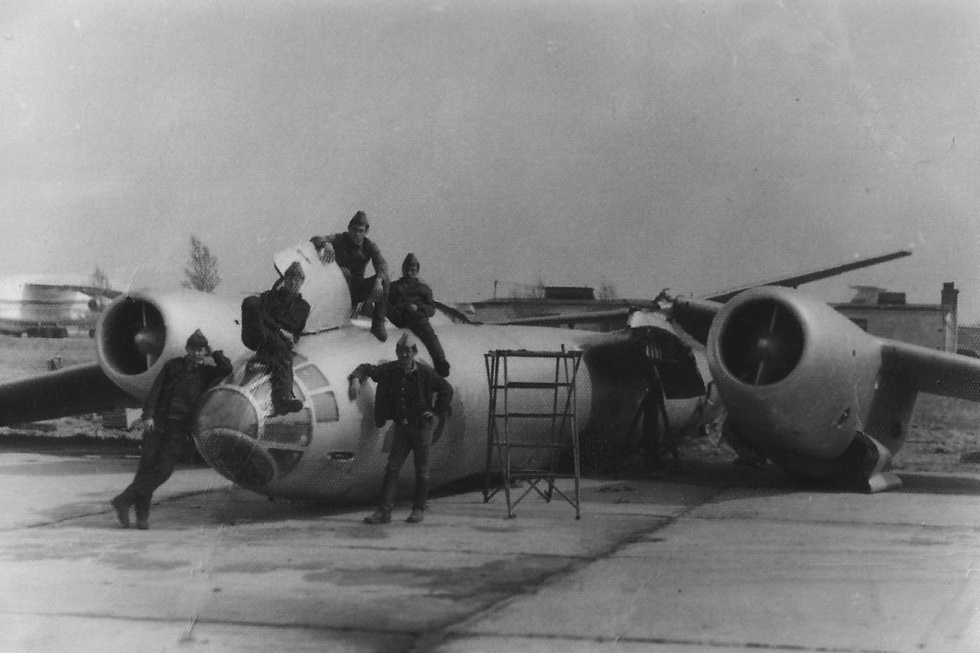In 1947, the USSR military industry received a license for the manufacture of British turbojet engines from Rolls-Royce, with Nin centrifugal compressors and a take-off thrust of 2270 kgf. In 1948, they began designing a jet front-line bomber, which became the Il-28. According to experts, this model is reliable and unpretentious in use. In the mid-1950s, the aircraft was the main one in the strike Soviet front-line aviation. The history and technical description of the IL-28 aircraft are presented in this article.
Acquaintance
The IL-28 is the first Soviet jet front-line bomber capable of transporting tactical nuclear weapons. In the NATO classification, this model is listed as the Beagle "The Hound." IL-28 aircraft (photo below) was designed at the experimental design bureau of the aviation complex named after S.V. Ilyushin. A group of designers was awarded the Stalin Prize.
About the history of creation
In June 1948, the USSR government decided to create a front-line bomber using a turbojet engine of the British Rolls-Royce company. At that time, it was already licensed in the territory of the Soviet Union. In 1949, state tests of the IL-28 aircraft were carried out, with the RD-45F engine installed. Testing lasted for 75 hours. Over 84 flights, the expert commission identified 80 structural defects. To eliminate them, the developers had to spend 4 months. Design was carried out in the conditions of fierce competition with an experienced design office named after Tupolev. From this design bureau, their aircraft models, Tu-37 and Tu-78, were also delivered for testing. Unlike the Il 28 aircraft, Tupolev vehicles carried numerous defensive weapons, had a large mass and crew. Soon, testing continued with the participation of a new model from OKB. Tupolev - Tu-14, a twin-engine bomber, the crew of which consisted of three people. This aircraft used one stern cannon mount. Despite the fact that the Tu-14 was designed for a long range, it would be problematic to produce it, as well as to operate it.

Total
In May 1949, JV Stalin held a special meeting at which the characteristics of the Il 28 aircraft were examined in detail. After reviewing the data presented and listening to the military’s point of view, Stalin ordered the Il-28 to be adopted by the Soviet army. In order to increase the speed of the aircraft to 900 km / h, the designers decided to install a more powerful VK-1 engine on it, the take-off thrust of which was 2700 kgf. In August, the already completed IL-28 was sent to state tests again. Testing took place at the Moscow Military District. The general public decided to show the IL 28 aircraft (photo of this aviation unit in the article) on Victory Day in 1950 over Red Square.
About production
Serial production of aircraft was organized in Moscow at plant No. 30, Voronezh (No. 166) and Omsk (No. 64). In addition, the IL-28 was also produced at factories Nos. 1 and 18. In 1950, an aviation unit was ready for training purposes. In the technical documentation, it is listed as IL-28U. A year later, they created a plane for transporting torpedoes (IL-28T). Reconnaissance tasks were to be carried out with the help of the Il-28R aircraft. In total, at least 6300 units were produced by the military industry of the Soviet Union. For painting aircraft used "silver". Exported IL-28s to other countries were painted with various types of camouflage. The dashboard was painted black, the chassis and the cargo compartment were gray. According to aviation experts, it happened that cargo compartments and niches only primed.
About design
Aircraft with a pressurized and soundproofed cockpit, a direct two-span monoblock monoblock wing of a trapezoidal shape. Its mechanization is carried out by means of conventional flaps, which during landing deviate at an angle of 50 degrees and by 20 during take-off. Made of duralumin alloy D16T. By means of ailerons, the aircraft was controlled by roll. IL-28 is equipped with a symmetrical keel and a stabilizer Naca-00. Electric steering is provided for the steering wheel and ailerons. The trimer RV is regulated by mechanical cable wiring and gear mechanisms. The aircraft was equipped with two starters-generators GSR-9000 DC and two batteries 12-A-30, which were used in the car as a source of electricity.
About engines
The location of the power units VK-1 became wing gondolas. To control the engines in the aircraft there is cable wiring. During start-up, each VK-1 spins with an electric starter. The fuel system is fuselage soft rubber tanks. Their total capacity is 7908 liters. Only the left engine is equipped with a hydraulic pump. If the hydraulic system suddenly fails, then flaps descend from the pneumatic system, and the wheels brake emergencyly. Also, with the help of air, the cargo compartment opens, namely the bomb-gate flaps. Both engines are equipped with pneumatic pumps. In addition, the IL-28 with emergency cylinders, which contain compressed air.
About the chassis
Aircraft with a three-landing gear for which air-oil cushioning is provided. The chassis consists of a front leg and two main legs. As a hydraulic shock-absorbing liquid, aircraft manufacturers decided to use an alcohol-glycerin mixture. The front leg is contained in the fuselage, and the racks are in front in the nacelles. The release and cleaning of the chassis is controlled by an air system, which was later replaced by hydraulics.
About weapons
The crew of this aircraft could destroy the target using the FAB-100 bombs. In total, there were 12 such shells on the IL-28. Also, the bomber could be equipped with FAB-250M46 in the amount of 8 pieces, or two FAB-500M46, or one FAB-1500M46. Torpedo-loading models (IL-28T) were equipped with one RAT-52 torpedo, AMD-100 and AMD-500 Desna, Lira mines. For torpedoes, external suspension was used, for mines and bombs, cargo compartments. Later, the IL-28T began to be equipped with two torpedoes. The launch of torpedoes was carried out by means of PTN-45 sights. To install it on an airplane, Soviet aircraft manufacturers had to slightly change the glazing in the navigator’s cabin. Small arms are represented by two fixed cannons HP-23. The place of their installation was the nose of the fuselage. For IL-28T and IL-28R was provided for one gun. But one rifle unit relied 100 shells. In addition, the aircraft had two stern guns, which were controlled remotely using a hydraulic drive. 225 shells could be fired from a single barrel.

About radio equipment
IL-28 was equipped with the PSBN-N radar system, ARK-5 radio compass, RV-2 and RV-10 radio altimeters, RSIU-ZM radios, SRO radar transponder and SPU-5 intercom. In aircraft designed to perform reconnaissance missions, the availability of photo equipment is provided: three AFA-33, AFA-BA-40, AFA-75MK. The IL-28 has a FRL-1M photo set-top box, with which information from the screen of the radar system is recorded. In December 1953, a government decree was issued according to which the PSBN was replaced by the Kurs radar. Reconnaissance aircraft have containers containing dipole reflectors ASO-28 and special equipment "Sodium", the task of which is to reproduce radio interference.
TTX
The bomber has the following performance characteristics:
- Wingspan - 2150 cm, height - 670 cm.
- The total wing area is 60.8 square meters.
- A fully equipped aircraft weighs 18,400 kg, empty - 12,890 kg.
- The crew consists of three people.
- The maximum take-off weight is 23,200 kg.
- Aircraft with two turbojet engines (turbojet engines) VK-1A, with a thrust of 2700 kgf.
- At maximum speed, the IL-28 overcomes 906 thousand meters per second, and at cruising speed - 700.
- The indicator of the practical range of the bomber is 2370 km, the distillation - 2460.
- The aircraft with a take-off run of 965 m has a climb rate of 15 m / s.
- For each wing, a load of 291 kg / m 2 is found.
- The minimum load in the bomb bay is 1 thousand kg., The maximum - 3 thousand kg.
- The IL-28 is equipped with two 23-mm HP-23 cannons in the bow compartment and two HP-23 aft.
About operation
Deliveries of IL-28 to the People's Republic of China were established. Soon in the PRC, local designers mastered production and began to produce similar aircraft at the plant in Harbin, but already as the N-5. Six such aircraft units from China were purchased by Romania. Finland also acquired IL-28 from the USSR, where 4 bombers were used to tow targets. In 1955, 30 Soviet aircraft were delivered to Egypt. Operator countries include countries such as Algeria, Bulgaria, Czechoslovakia, East Germany, Vietnam, North Korea, Yemen, Morocco, Cuba, Somalia, Syria, Indonesia and Nigeria. The IL-28 was used quite successfully in the highlands in Afghanistan. In the Soviet Union itself, the aircraft was not used for long.

At the end of 1950 He began to replace the Yak-28. According to eyewitnesses, the IL-28 was decommissioned and disposed of in the most barbaric way: they were trampled using tractors and bulldozers. Part of the aircraft was converted to training. Some IL-28s until 1980 used as target towers.
Model aircraft IL-28
Judging by the reviews, a lot of people are fond of bench modeling. For those who are interested in this topic, in March 2007 the Internet project “Karopka.ru” was created. The IL-28 plane, namely a set of parts for it, is one of the most bought.

Those modeling lovers who have encountered difficulties during the assembly have the opportunity to ask questions and consult experts at Karopka.ru. Mostly beginners have problems with masks for the model. The mask in bench modeling is a protective layer that is applied to a surface that is not painted with an airbrush. After painting the remaining sections, the mask is removed. The result should be the border between the painted and unpainted area. Judging by numerous reviews, Trumpeter masks are suitable for the IL-28 model. The set consists of 178 parts. For the manufacture of 169 gray plastic is used, for the rest - transparent. It is completed with instructions and decals with Soviet and Chinese identification marks. You can buy a model for 700 rubles.